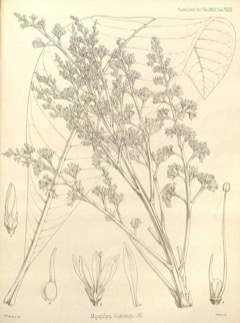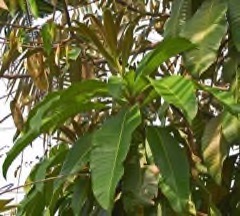 |
|
http://www.edibleplants.org |
 |
| W.A. Djatmiko wikimedia.org |
Translate this page:
Summary
Mangifera kemanga or Kemang is a tropical, large tree native to Southeast Asia. It is deciduous and with a dome-shaped canopy. It reaches a height of 30 m upon maturity. The leaves have very short stalks. The yellowish-brown, pear-shaped fruit is fibrous and juicy, and has a strong flavor. Young leaves are consumed raw or cooked. The seed can be grated and used in dishes.
Physical Characteristics

 Mangifera kemanga is a deciduous Tree growing to 30 m (98ft) by 30 m (98ft) at a medium rate.
Mangifera kemanga is a deciduous Tree growing to 30 m (98ft) by 30 m (98ft) at a medium rate.
See above for USDA hardiness. It is hardy to UK zone 10. The flowers are pollinated by Insects.
Suitable for: light (sandy), medium (loamy) and heavy (clay) soils. Suitable pH: mildly acid and neutral soils. It cannot grow in the shade. It prefers moist soil.
UK Hardiness Map
US Hardiness Map
Synonyms
Plant Habitats
Edible Uses
Edible Parts: Fruit Leaves Seed
Edible Uses: Drink
Fruit. The very juicy, very fibrous, copious white pulp has a strong flavour that some find agreeable and others offensive[894 ]. Kemang fruit is eaten fresh when ripe, or used for home-made juice. It is used unripe to make 'rujak', a dish of sliced green fruit covered with a spicy sauce. A drink make from the juice with sugar, ice and a pinch of coffee powder is highly esteemed[894 ]. The yellowish-brown fruit is pear-shaped, containing a single, large seed[894 ]. Young leaves - raw or cooked. They are commonly eaten in 'lalab', a dish of fresh leafy vegetables to accompany rice[303 , 894 ]. Occasionally a dish is made from fresh, grated seeds, with fermented soya beans and spices[303 ]. The grated seed has been used to prepare the sambal kemang, with the addition of chili and salt[894 ].
References More on Edible Uses
Medicinal Uses
Plants For A Future can not take any responsibility for any adverse effects from the use of plants. Always seek advice from a professional before using a plant medicinally.
None known
References More on Medicinal Uses
The Bookshop: Edible Plant Books
Our Latest books on Perennial Plants For Food Forests and Permaculture Gardens in paperback or digital formats.

Edible Tropical Plants
Food Forest Plants for Hotter Conditions: 250+ Plants For Tropical Food Forests & Permaculture Gardens.
More

Edible Temperate Plants
Plants for Your Food Forest: 500 Plants for Temperate Food Forests & Permaculture Gardens.
More

More Books
PFAF have eight books available in paperback and digital formats. Browse the shop for more information.
Shop Now
Other Uses
References More on Other Uses
Cultivation details
A plant of the wet, tropical lowlands, where it is usually found at elevations below 400 metres, but rarely up to 800 metres[303 ]. It requires a rainfall which is evenly distributed through the year[303 ]. The plant stands inundation well and is commonly cultivated on periodically inundated riverbanks in East Kalimantan[303 ]. Mature trees require much space, 12 - 16 metres each way being typical[303 ]. Natural hybrids between Mangifera kemanga and Mangifera caesia, showing intermediate characteristics, are found in orchards in East Kalimantan[303 ].
References Carbon Farming Information and Carbon Sequestration Information
Temperature Converter
Type a value in the Celsius field to convert the value to Fahrenheit:
Fahrenheit:
The PFAF Bookshop
Plants For A Future have a number of books available in paperback and digital form. Book titles include Edible Plants, Edible Perennials, Edible Trees,Edible Shrubs, Woodland Gardening, and Temperate Food Forest Plants. Our new book is Food Forest Plants For Hotter Conditions (Tropical and Sub-Tropical).
Shop Now
Plant Propagation
Seed - It is propagated from seed, an indication that the agronomy of the crops has received little attention. Presumably grafting on seedling stock would be possible, in particular through inarching potted, decapitated rootstocks into twigs of mother trees. Grafting on Mangifera indica L. has been attempted without success, probably because this species is not closely related[303 ].
Other Names
If available other names are mentioned here
Kemang, Palong,
Native Range
TROPICAL ASIA: Indonesia (Jawa (west), Kalimantan, Sumatera), Malaysia (Malaya)
Weed Potential
Right plant wrong place. We are currently updating this section.
Please note that a plant may be invasive in one area but may not in your area so it's worth checking.
Conservation Status
IUCN Red List of Threatened Plants Status : This taxon has not yet been assessed

Growth: S = slow M = medium F = fast. Soil: L = light (sandy) M = medium H = heavy (clay). pH: A = acid N = neutral B = basic (alkaline). Shade: F = full shade S = semi-shade N = no shade. Moisture: D = dry M = Moist We = wet Wa = water.
Now available:
Food Forest Plants for Mediterranean Conditions
350+ Perennial Plants For Mediterranean and Drier Food Forests and Permaculture Gardens.
[Paperback and eBook]
This is the third in Plants For A Future's series of plant guides for food forests tailored to
specific climate zones. Following volumes on temperate and tropical ecosystems, this book focuses
on species suited to Mediterranean conditions—regions with hot, dry summers and cool, wet winters,
often facing the added challenge of climate change.
Read More
Expert comment
Author
Blume
Botanical References
Links / References
For a list of references used on this page please go here
A special thanks to Ken Fern for some of the information used on this page.
Readers comment
| Add a comment |
|
If you have important information about this plant that may help other users please add a comment or link below. Only comments or links that are felt to be directly relevant to a plant will be included. If you think a comment/link or information contained on this page is inaccurate or misleading we would welcome your feedback at [email protected]. If you have questions about a plant please use the Forum on this website as we do not have the resources to answer questions ourselves.
* Please note: the comments by website users are not necessarily those held by PFAF and may give misleading or inaccurate information.
To leave a comment please Register or login here All comments need to be approved so will not appear immediately.
|
Subject : Mangifera kemanga
|
|
|
|